SmokeHouse423
Elite
I am disappointed in myself for real. Should have got more recs on here
Post vid of you setting them ablaze in your driveway
I am disappointed in myself for real. Should have got more recs on here
I did some shoulder press stuff, maybe 30 minutes. A little light headed, a little out of breath, but all good. I started mostly feeling better yesterday as reference
I had to ease back into it after covid. My whole family got it one after another (me last) and by the time it was all done, it had been 3 weeks or so of not working out, then had to get the energy and stamina back. Has taken a while and some days still feel weaker. Just listen to your body and don't overdo it initiallyI think you're doing the right thing. Doing whatever training you can while being aware of how your body is responding to it.
Haven't had COVID but whenever I've been sick I just keep doing my thing. I am aware that I could be weaker due to my body fighting an infection so I don't care about the numbers for those few days.
I believe my case was pretty mild, but I felt pretty shitty Wednesday and Thursday. Still lightheaded and having shortness of breath thoughI had to ease back into it after covid. My whole family got it one after another (me last) and by the time it was all done, it had been 3 weeks or so of not working out, then had to get the energy and stamina back. Has taken a while and some days still feel weaker. Just listen to your body and don't overdo it initially
I’m a poor right now so once I get something figured out I would be honoredPost vid of you setting them ablaze in your driveway
Yeah, but it can still have a weird effect on your heart and lungs. If I was you, (or anyone that had covid recently) I would take aspirin daily for 2-3 months. Try to keep the blood thin and keep those spike proteins from clotting at allI believe my case was pretty mild, but I felt pretty shitty Wednesday and Thursday. Still lightheaded and having shortness of breath though
I bought some this weekend. Aside from all of the health benefits, it also increases nitric oxide production which helps to expand your veins and vessels, in all parts of your body. (See number 1)A product that I've been using regularly is organic beet root juice powder. Beets are great for you, but I don't really eat them on a regular basis. Mix 1-2 small scoops of this stuff in a glass of water and down it for all the added health benefits.
View attachment 78605
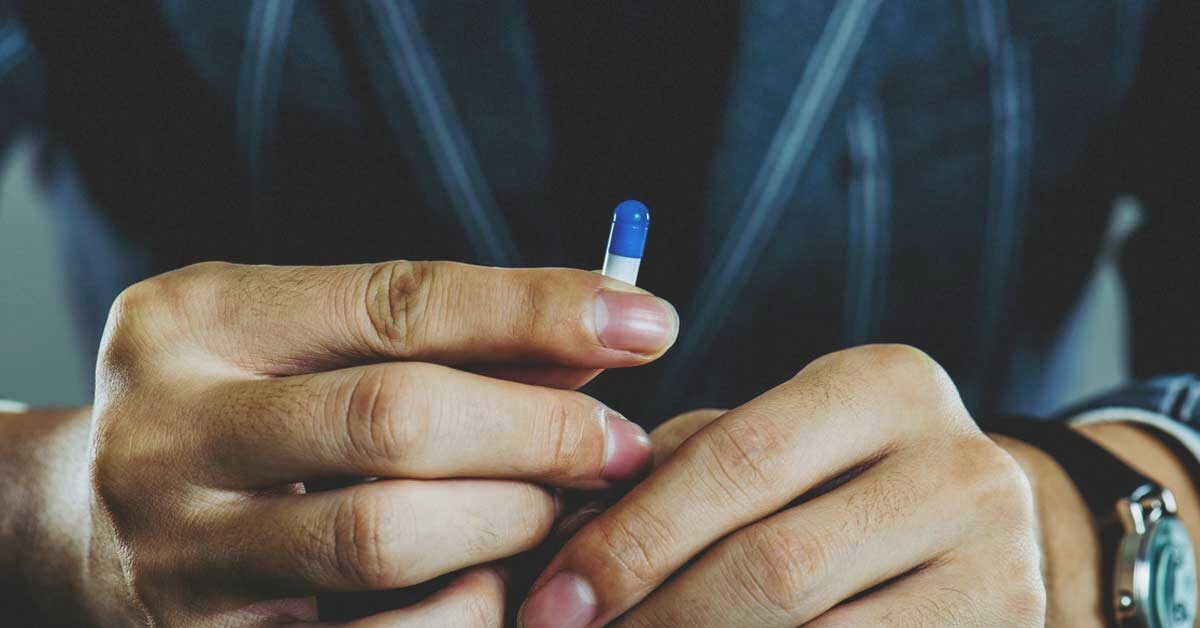

Exactly. I was considering that as part of the benefits. And it actually tastes pretty good. I mix in a scoop of amino/electrolyte powder and it makes it even better.I bought some this weekend. Aside from all of the health benefits, it also increases nitric oxide production which helps to expand your veins and vessels, in all parts of your body. (See number 1)

5 Health Benefits of Nitric Oxide Supplements
Supplements that increase nitric oxide in the body are incredibly popular. Here are 5 benefits of nitric oxide supplements for health and performance.www.healthline.com

How to Increase Nitric Oxide Naturally: 5 Ways
Maintaining optimal levels of nitric oxide in your body is essential for your overall health. This article reviews the top 5 ways to increase your nitric oxide production naturally.www.healthline.com
I think it tastes like dirt but I don't mind it, I usually just chug it. The benefits greatly outweigh the less than pleasant taste for me.Exactly. I was considering that as part of the benefits. And it actually tastes pretty good. I mix in a scoop of amino/electrolyte powder and it makes it even better.
That particular brand that I included in my previous post isn't too bad IMO. Basically tastes like beets, but slightly watered down.I think it tastes like dirt but I don't mind it, I usually just chug it. The benefits greatly outweigh the less than pleasant taste for me.
A product that I've been using regularly is organic beet root juice powder. Beets are great for you, but I don't really eat them on a regular basis. Mix 1-2 small scoops of this stuff in a glass of water and down it for all the added health benefits.
View attachment 78605
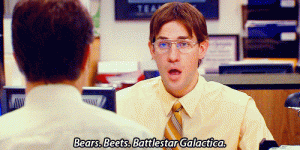
Just do what you can. Better than nothing at all, even if its just walking or a light liftI put on my workout clothes and toes my shoes and then my energy level just bottomed out. Assuming covid related
I’ve learned though that if I just get my workout gear on, it’s enough momentum to make the workout happen. Just strange circumstances right now
I think we all have those days, so it may or may not be covid related. Assuming not covid related/being sick, those are the days to just do what you can to get that mental win, that you really didn't want to but pushed through and got it done anyways. I've never regretted doing a workout but I have regretted missing when I had a choice not to.I put on my workout clothes and toes my shoes and then my energy level just bottomed out. Assuming covid related
I’ve learned though that if I just get my workout gear on, it’s enough momentum to make the workout happen. Just strange circumstances right now


“When I was training as a student in medicine, Scotland had the highest rate of heart disease in the world. Early on the answer for why was, ‘Oh, well, it’s because we have such terrible diet, and we eat rubbish food like deep fried Mars bars.’
So, you eat too much saturated fat, the saturated fat gets turned into cholesterol in your bloodstream, and then it’s absorbed into arteries and forms narrowings and thickenings, which all sounds plausible if you don’t think about it too hard.
But I also happen to go to France quite a lot, and what I noticed about France was, they eat a lot of saturated fat. They eat more, in fact, than anyone else in Europe, and certainly more than Scotland. So, [this saturated fat] hypothesis certainly didn’t work for the French. They have the highest saturated fat intake in Europe and lowest rate of heart disease, and this has been the case for decades.
If you took all the risk factors for France and Scotland [such as smoking, high blood pressure and diabetes], then the French had slightly [higher risk], according to conventional thinking. But, in fact, they had one-fifth [the rate among age-matched men].
So, I thought, this is interesting. It doesn’t make much sense according to what we’re told. Then while I was in medical school, a tutor in cardiology said … LDL cannot cross the endothelium. At the time, I didn’t know what LDL was, nor did I know what the endothelium was, but it sounded important.
She had been looking at heart disease as a different process for decades … So, I think that’s really where I got started. Once you start questioning what the problem is, you end up questioning more and more and you start thinking, gosh, this is just nonsense, isn’t it? This whole hypothesis is just nonsense. So, I started picking it apart.”
“The atherosclerotic plaque is basically a buildup of blood clot, repair, blood clot, repair, blood clot, repair,” Kendrick explains. “If the blood clotting process is faster than the repair process, you have a plaque that gradually grows and eventually thickens the artery wall until it narrows sufficiently that the final blood clot, on top of the existing plaque, is the thing that can cause a heart attack or stroke …
If you cut through the plaque and look at it, it almost looks like tree rings. You can see there’s been a clot, repair, clot, repair, clot, repair, clock, repair over the years.
It’s widely accepted that a blood clot forming on an existing plaque will cause the plaque to grow in size. You can find 10,000 papers saying that this is the case. What the mainstream won’t accept is that a blood clot on a healthy artery wall can initiate the whole process.
As noted by Kendrick, the conventional view is that low-density lipoprotein or LDL gets into the artery wall where it initiates plaque formation. It then, inexplicably, stops initiating plaque, and the plaque continues to grow through the addition of repeated clots.So, to an extent, all I’m saying to people is, well, we know blood clots cause the final event. We know blood clots cause plaques to grow. Why won’t you accept that blood clots are the thing that starts it in the first place? Because then we have one process all the way through, and it makes sense, because it fits with what you can see.”
“Your blood vessels are lined with endothelial cells, a bit like tiles on a wall. Endothelial cells are also covered themselves in a thing called glycocalyx. If you try to pick up a fish, it’ll slip through your fingers; it’s very slippery. The reason it’s slippery is because it’s covered in glycocalyx and the glycocalyx is incredibly slippery. It’s nature’s Teflon.
So basically, in our case, the glycocalyx [is inside] our blood vessels, to allow the blood to travel through without it sticking, without damage occurring. So, you have this kind of damage-repellent layer on top of your endothelial cells.
The blood clot doesn’t just keep on growing and growing. If it did, you’d die anytime you had a blood clot. Instead, when a clot forms, other processes step in to prevent it getting too big, which is why every blood clot doesn’t cause a stroke or heart attack. Once the clot has stabilized, and has been shaved down, the area is covered over by endothelial progenitor cells, made in the bone marrow, that float around in your blood stream.Now, if that layer is damaged, and then the endothelial cell itself underneath is damaged, then the body will say, ‘Oh, we’ve got damage to a blood vessel, we must have a blood clot there because we could bleed out.’ So, a blood clot forms on the area of damage, and immediately stops [the bleeding].”
“The COVID virus enters endothelial cells through the ACE2 receptor. It prefers endothelial cells because they’ve got ACE2 receptors on them. It gets into the endothelial cell and starts replicating, then bursts out, damaging the cell. Bingo, you’ve got an area of damage.
Of course, added to this, when cells have viruses within them, they send out distress signals to the immune system saying, ‘I’ve been infected, come and kill me,’ and so the immune system starts to have a go at the endothelial cells. This is why you can get a problem, because the endothelial cells are being damaged and stripped off.
Blood clotting occurs at the points of damage and hey, presto, you’re having clotting, you’re having strokes, you’re having heart attacks, which is the thing that people at first couldn’t understand [about COVID-19]. Yet it’s very clear that what’s happening is you’ve got damage to the endothelial cells.
Obviously, you and I both know that if you get a [COVID jab], the cells are triggered to produce the spike protein, and these cells are sending out distress messages saying, ‘I’m infected.’ You have to be very careful if you want to stick something into cells that then says to the immune system, ‘Please come and destroy me,’ because that’s what the immune system is going to do.
But moving on from that, what other thing can cause endothelial damage? The answer is things like smoking. Smoke particles get out of your lungs, they go into your blood vessels and they cause damage … You smoke one cigarette and a whole bunch of microparticles appear in your bloodstream, which means endothelial cells are dying.
Luckily as endothelial cells die, another message is sent to the bone marrow saying, we need more endothelial cells and it stimulates endothelial progenitor cell production. These endothelial progenitor cells rush around covering over the areas of damage.
Other things that can cause endothelial damage include:Some smokers have enough repair going on and when you’re younger, it’s okay. As you get older and your repair systems begin to fail a bit, cigarette smoking becomes more and more of a problem.”
“If you try and explain that through the LDL mechanism, it just doesn’t work,” Kendrick says. “They have discovered that if you give chondroitin sulfate as a supplement — which normally is for arthritis and stuff like that — it reduces the risk of heart disease quite considerably. How do you explain that? Well, you can explain that because you’re protecting your glycocalyx.
These are the sort of things that make no sense if you like looking at the conventional ideas of heart disease, but are immediately and easily explained if you say, ‘We have to keep our glycocalyx healthy and we have to keep our endothelial cells underneath them healthy.
Otherwise they will be damaged and stripped off, and then we will get a blood clot, and if we keep getting blood clots at that point, we will end up with a plaque and eventually one of the blood clots on that plaque will kill you from a heart attack or a stroke.”
“NO protects the endothelium. It is anticoagulant — the most potent anticoagulant we have in the body. It’s really the magic molecule for cardiovascular health,” Kendrick says.
“At one time NO was known as Endothelial Derived Relaxation Factor (EDRF) NO was something no one believed could possibly exist in the human body. NO is actually a free radical. Everyone says free radicals are terribly damaging and unhealthy.
Some anticancer drugs are designed to block VEGF, as the tumor needs angiogenesis — which is the creation of new blood vessels that are required to provide sufficient ‘nutrients’ Without these new blood vessels, the tumor dies off. Unfortunately, if you block VEGF, you also block NO, which then raises your risk for heart disease.To that I reply, ‘Well, you may wish to know that the chemical that is the single most important protective chemical in the body for the cardiovascular system is an incredibly free radical called nitric oxide.”
“These drugs were almost removed from the market,” Kendrick says, “because despite their anticancer activity, they were procardiovascular disease to quite a scary degree.
[That’s why], if you are given bevacizumab or Avastin as an anticancer drug, they now give you angiotensin converting enzyme inhibitors (ACE inhibitors), which are blood pressure lowering tablets, and ACE inhibitors have a specific impact on bradykinin, which increases NO synthesis.”
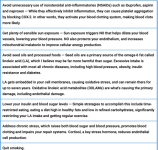
Is it just a coincidence that you were talking about beet root powder yesterday or have you been researching this type of stuff for a while?What Damages Endothelial Cells?
The question is, what can damage the endothelium in the first place? Here, Kendrick uses the SARS-CoV-2 mechanism as an example:
Other things that can cause endothelial damage include:
• High blood sugar levels and diabetes. The protective glycocalyx layer is made of proteins and sugars — High blood sugar damages the glycoprotein layer, thinning it down in a measurable way. High blood sugar can reduce the glycocalyx layer by as much as two-thirds. This, in turn, exposes the endothelial cells to the bloods and anything else damaging that might be there.
The damage to the glycocalyx is why diabetics are prone to both arterial and capillary (small vessel) disease. You can’t get atherosclerosis in the capillaries, as there’s no room. Instead, the capillaries become broken down and destroyed. This in turn can cause ulcers, due to poor circulation in the skin of your legs and feet.
Peripheral neuropathy as the ends of nerve cells are deprived of oxygen. Also visual problems (diabetic retinal damage) and kidney damage. Blood pressure may also become elevated as your heart has to work harder to push blood through a network of damaged/missing small blood vessels.
• Heavy metals such as aluminum and lead.
• High blood pressure, as it puts stress on the endothelium — Atherosclerotic plaques (atherosclerosis) doesn’t occur unless the pressure is raised, adding biomechanical stress.
Repairing the Glycocalyx
As explained by Kendrick, the glycocalyx layer resembles a lawn, with slippery filaments that stick up. Within this glycocalyx layer you have nitric oxide synthase (NOS), which produces nitric oxide (NO), and you have NO itself, as well as a number of other anticoagulant proteins. The glycocalyx is actually a potent anticoagulant layer, so it stops blood clots forming. If glycocalyx is damaged, your risk of blood clotting increases.
“It’s a very complicated layer,” Kendrick says. “It’s like a jungle full of things that say, ‘Don’t stick to this, stay away from this.’” Within it, you also have albumin, protein complex produced by the liver. Albumin contains the proteins that help maintain and repair the glycocalyx. A fact that most doctors are unaware of is that, if you have a low albumin level, you’re significantly more likely to die of heart disease.
The good news is that while the glycocalyx layer can be rapidly destroyed, it can also be rapidly repaired. (Experiments have shown that in an area where the glycocalyx has been completely stripped off, it can be completely repaired in a single second.) Supplements like chondroitin sulfate and methylsulfonylmethane (MSM) can be helpful in this regard.
Blood Flow Restriction Training
A lifestyle strategy that can help repair endothelial damage is blood flow restriction (BFR) training. In response to BFR, your body produces vascular endothelial growth factor (VEGF), which acts as “fertilizer” for the endothelium. You can learn the ins and outs of BFR in my free BFR report. VEGF also induces the synthesis of nitric oxide (NO), a potent vasodilator, and it stimulates endothelial progenitor cells.
Some anticancer drugs are designed to block VEGF, as the tumor needs angiogenesis — which is the creation of new blood vessels that are required to provide sufficient ‘nutrients’ Without these new blood vessels, the tumor dies off. Unfortunately, if you block VEGF, you also block NO, which then raises your risk for heart disease.
Strategies to Lower Your Thrombotic Risk
In his book, “The Clot Thickens: The Enduring Mystery of Heart Disease,” Kendrick reviews many different strategies that can lower your disease risk. Here’s a short-list of examples covered in far greater depth in the book, as well as some of my own recommendations that I bring up in the interview:
View attachment 78845
View attachment 78846
Actually just a coincidence. That article came up on the epoch times website this morning. I have looked into the benefits of the beet root juice with regards to the nitric oxide, but the timing of this article is just coincidental.Is it just a coincidence that you were talking about beet root powder yesterday or have you been researching this type of stuff for a while?
Interesting article, I enjoy learning about this type of stuff. It shows how incredibly complex the human body truly is.
I've done some BFR training before mostly because it sounded cool. Interesting to know that there may be an underlying benefit aside from the muscle training itself.
Clearly the media is coming over to the FSF to get ideas for good content!Is it just a coincidence that you were talking about beet root powder yesterday or have you been researching this type of stuff for a while?
Interesting article, I enjoy learning about this type of stuff. It shows how incredibly complex the human body truly is.
I've done some BFR training before mostly because it sounded cool. Interesting to know that there may be an underlying benefit aside from the muscle training itself.
Do you even Nitric oxide bro?Back in the swing today.
Someone convince me why beet powder is not a meme
I remember the nitric oxide stuff back in the day. Made the veins popDo you even Nitric oxide bro?
Back in the swing today.
Someone convince me why beet powder is not a meme
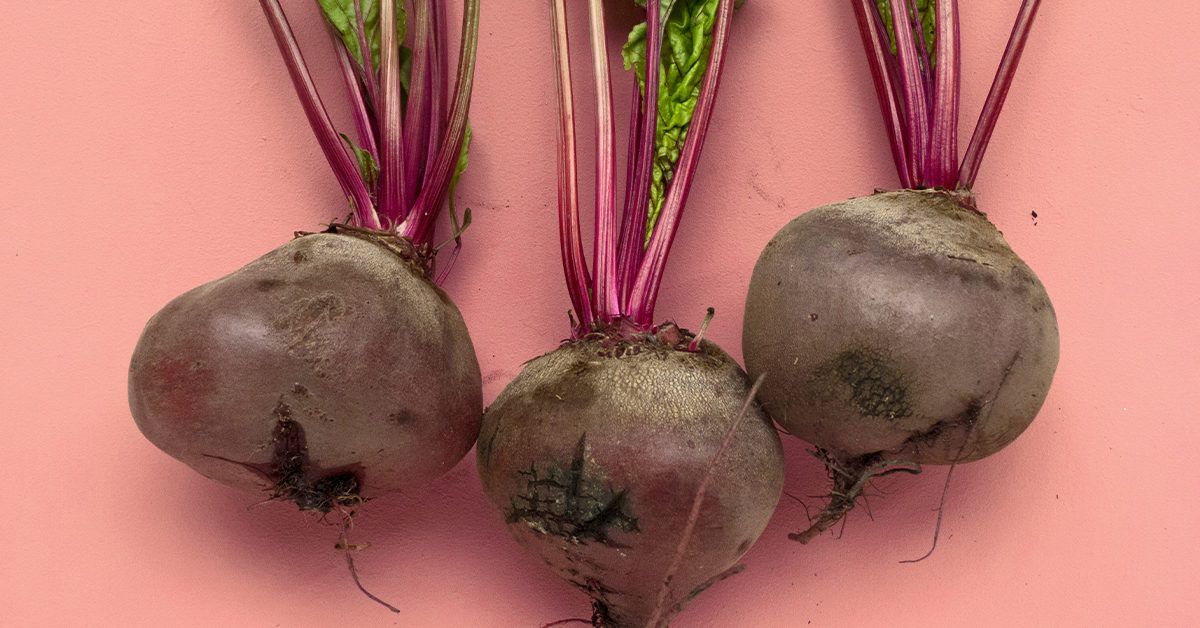
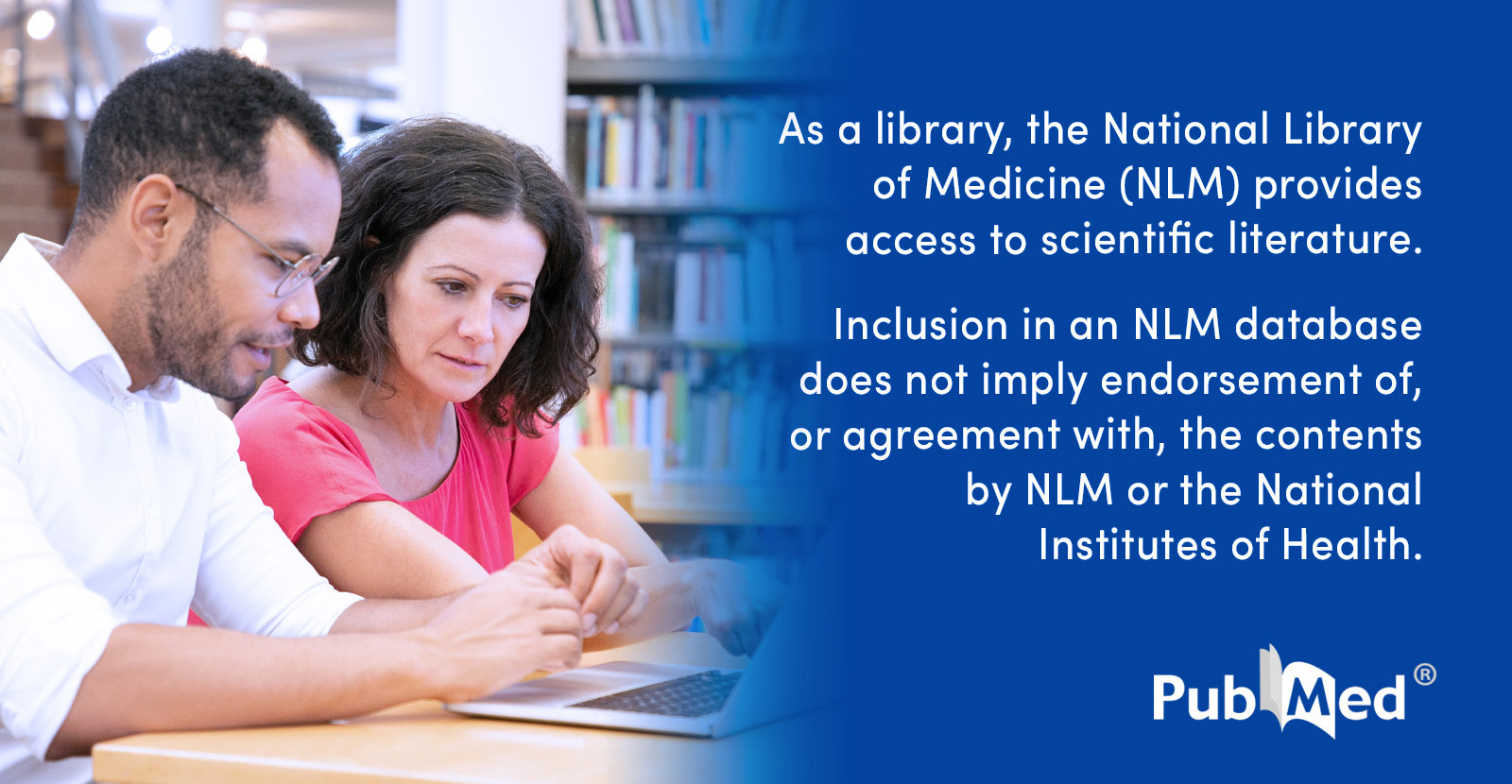
I’m interested. Mainly because I want red pee.From this article above:
11 Reasons to Drink More Beet Juice
Nutrient-rich beet juice has a number of health benefits, such as lowering blood pressure and reducing cholesterol. Discover more here.www.healthline.com
-helps lower blood pressure
-improves stamina
-may slow progression of dementia
-helps you maintain a healthy weight
-may prevent cancer
-good source of potassium
-good source of iron, mg, mn, sodium, zinc, copper, selenium, folate
-supports your liver
-may reduce cholesterol
Here's a study that talks about benefits of Nitric oxide:

The benefits and risks of beetroot juice consumption: a systematic review - PubMed
Beetroot juice (BRJ) has become increasingly popular amongst athletes aiming to improve sport performances. BRJ contains high concentrations of nitrate, which can be converted into nitric oxide (NO) after consumption. NO has various functions in the human body, including a vasodilatory effect...pubmed.ncbi.nlm.nih.gov
Here's a good excerpt:
"Nitric Oxide has various functions in the human body, including a vasodilatory effect, which reduces blood pressure and increases oxygen- and nutrient delivery to various organs. These effects indicate that BRJ may have relevant applications in prevention and treatment of cardiovascular disease. Furthermore, the consumption of BRJ also has an impact on oxygen delivery to skeletal muscles, muscle efficiency, tolerance and endurance and may thus have a positive impact on sports performances."
Although I don't typically prefer to use Amazon, it was the most convenient for me on this order. I got this:I’m interested. Mainly because I want red pee.
“Your urine and stools may turn red or pinkish after eating beets. This condition, known as beeturia, is harmless. However, it may be startling if you don’t expect it.”
But I’ve got high blood pressure so I’m gonna give it a shot. Where do you get yours from?
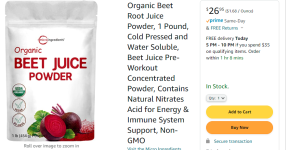
Appreciate it. I know you had made posts about this above so sorry for being lazyAlthough I don't typically prefer to use Amazon, it was the most convenient for me on this order. I got this:
Beet it
View attachment 78877
Sorry to disappoint you, but I've not yet had any red urine. Something to hope for thoughI’m interested. Mainly because I want red pee.
“Your urine and stools may turn red or pinkish after eating beets. This condition, known as beeturia, is harmless. However, it may be startling if you don’t expect it.”
But I’ve got high blood pressure so I’m gonna give it a shot. Where do you get yours from?
Beet juice en route. Should be here fridayAlthough I don't typically prefer to use Amazon, it was the most convenient for me on this order. I got this:
Beet it
View attachment 78877
Glad to hear it. I've been tackling a bunch of projects recently, so my workouts have been taking a hit. At least I'm active and producing some good stuff, but need to get back into the weights too.60 Jump Ropes
15 hang power snatches
Repeat AMRAP for 10 minutes.
Was about 85-90% intensity for me. I’m back!
That's awesome. Unless I build myself a garage / shed out in the yard, I won't be able to get a setup like that.Posted this before in another thread somewhere, but took me about 7 years to pull all this stuff together. When we bought our last house a couple years back my only demand was a detached garage for me to put my gym in
View attachment 79110
That's awesome. Unless I build myself a garage / shed out in the yard, I won't be able to get a setup like that.
Is that a pullup band I see on the right? I almost posted those last week as a great thing to get to assist on the pull workouts. Do you use it for anything else?
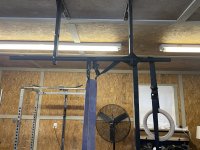
I have the olympic style cage that has the pull up bar on it, but it sure would be nice to have it up another foot or so.View attachment 79111
Yeah pull-up bar. I use that band for assisted, but I can do a good bit of pull-ups for a 250 lb boy. Hang some rings for ring dips.
Mounting a pull-up bar on the crossbeams of the garage is one of the best things I’ve ever done.
I really like the stability. Solid as a rock, but probably makes more of a difference for me because I’m a hossI have the olympic style cage that has the pull up bar on it, but it sure would be nice to have it up another foot or so.
I sacrificed my parking spot on the garage for my gym before my first son was born and it's been one of the best decisions I made.Posted this before in another thread somewhere, but took me about 7 years to pull all this stuff together. When we bought our last house a couple years back my only demand was a detached garage for me to put my gym in
View attachment 79110
